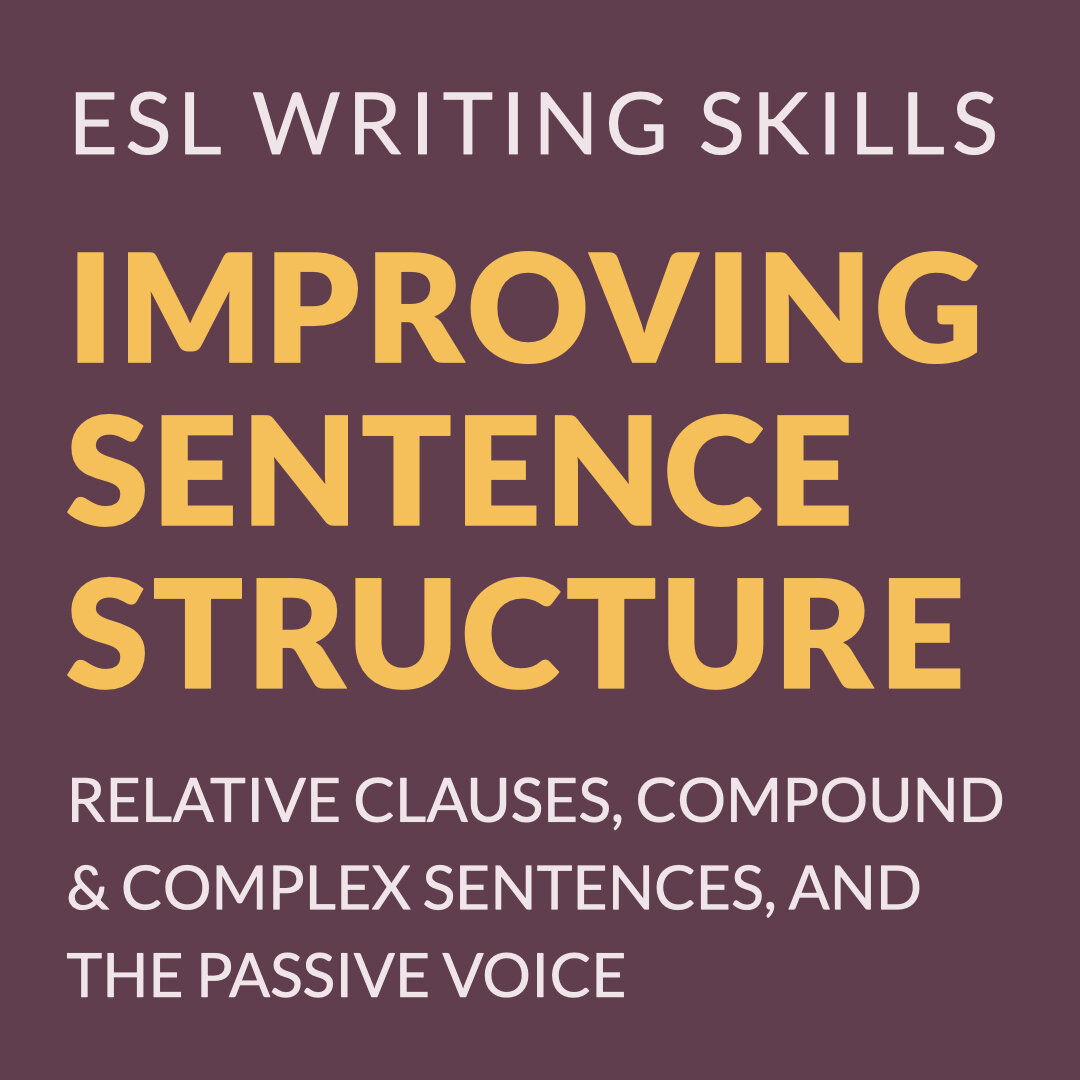Common Sentence Structure Problems and How to Fix Them With Exercises
Writing can be one of the hardest skills to master and practice in any language, and English is no exception! And part of what makes it so challenging is problems with sentence structure.
Think about it: Sometimes constructing a sentence is like putting a puzzle together: At first, it’s not too hard to get the basic structure, but it gets harder the further you go along.
It feels so impossible to some of my students that they don’t practice it much at all or they give up on it entirely.
Which makes sense! So many English learners are put in a position where they feel like they have to improve their skills quickly, and writing isn’t usually the first one they worry about because it’s not as important for them to get by in certain situations.
And, in this way, they feel like they’re being held back from making progress because just don’t have time to focus on writing and correcting sentence structure problems in English.
So, that’s why today we’re going to talk about three sentence structure problems that might be holding you back in your English writing. You might be having trouble with:
Adverb placement in a sentence
Using transitional phrases in English
Making comparisons in English
We’ll also offer you some practice exercises to help you fix these common sentence structure problems. So, let’s get started.
Master Sentence Structures in English
Master the most challenging sentence structures in English: Compound & complex sentences, conditionals, the passive voice, relative clauses and reported speech.
SENTENCE STRUCTURE PROBLEMS WITH YOUR ENGLISH WRITING
Adverb Placement in a Sentence
Most declarative sentences in English follow the S + V + O structure, so where do adverbs go? Well, it depends.
Adverbs are words that describe verbs or adjectives. For example:
She ran quickly.
He answered all the questions incorrectly.
But we don’t always put adverbs at the end of the sentence the way we did with the above examples. And that can get confusing when you’re trying to write in English.
You’ve probably learned this general rule about using adverbs of frequency. Adverbs of frequency like often, never, sometimes, or always go after a to be verb but before any other kind of verb:
I often exercise.
I am rarely late for work.
We usually put adverbs of certainty (such as probably, certainly, or definitely) after a modal verb such as will or can.
He will probably be late.
I can definitely come.
But we put them before a negative modal verb:
He probably won’t be late.
I definitely can’t come.
When it comes to adverbs of opinion (adverbs that we use to describe an action like smartly, responsibly, reasonably), adverbs of place, or adverbs of time, we often put these at the end of a clause or sentence.
He drinks alcohol responsibly.
The kids are playing downstairs.
We’re leaving later.
But things can get confusing when we’re using different kinds of adverbs or adverbial phrases. So let’s take a look at a common mistake you might be making.
Where do you put adverbial phrases?
We use adverbial phrases to describe nouns, but it can get tricky when we’re not sure where to place them in the sentence.
For example, what about adverbial phrases like so much, a lot, or all the time? We also use these to talk about frequency or about a degree or quantity of something, but we usually put these at the end of a clause or sentence.
I love to exercise so much.
I am late for work a lot.
In this case, we don’t put these adverbial phrases before the verb. Here are some common mistakes that you might be making with these expressions:
He loves so much talking to other people.
He loves talking to other people so much.
They all the time go to the beach.
They go to the beach all the time.
She enjoys a lot listening to music.
She enjoys listening to music a lot.
Practice Exercise
Put the adverb where it belongs in the sentence.
(always) The neighbors make noise.
(so much) Annie and Jim love cooking together.
(definitely) He will be at the meeting.
(a lot) He forgets to lock the door.
(reasonably) We stated our issues.
Using Transitional Phrases in English
We use transitional words and phrases in English writing (and speaking) to make logical connections between our thoughts and ideas. They help organize your speech and your writing, especially when you’re writing essays. They sound complicated, but if you’ve used a sentence like these, you’ve used transitional phrases:
I have to work late, so I won’t be there for dinner.
Even though he forgot my birthday, I still had a good day.
We use them because it would be confusing to put two ideas together without connecting them, right?
But the tricky thing with transitional phrases is that we have so many different kinds, and some English learners aren’t sure how to use them. And, unfortunately, we don’t have one special rule that we can use for transitional phrases.
Transitional phrases are important because they help you to change your sentence variety, hold your reader’s attention, and make sure the reader actually understands what you’re talking about.
We prefer to group them according to how we use them. For example:
Comparing and contrasting
While
Similarly
On the other hand
Clarification
In other words
In basic terms
To put it another way
Cause and effect
As a result
Because of that
Unless
In most cases, we can use them to connect two clauses with a period, with a semicolon, or with a comma and/or conjunction.
He didn’t want to see anyone. On the other hand, he did want to get out of the house.
He didn’t want to see anyone; on the other hand, he did want to get out of the house.
He didn’t want to see anyone, but on the other hand, he did want to get out of the house.
However, with phrases like while, unless, or because, you usually have to follow them with a subject and verb to create a clause:
While their sales increased in 2012, they experienced a major decrease in 2015.
The residents were asked to stay inside because the streets were flooded.
Unless you are willing to pay a lot of money, you won’t be able to afford a long vacation.
If you’re making a lot of mistakes with transitional phrases in your English writing, practice them first according to their usage. So, practice using transitional phrases to compare and contrast something. Then move on to practicing transitional phrases for cause and effect.
The second trick is to make sure that both of your clauses follow the same structure. Use parallel structure in both of your clauses or sentences, and make sure your tenses agree.
They made most of their profit from video games, while they made almost no profit from snacks.
They made most of their profit from video games, while snacks didn’t sell very well.
Some students have too much homework. As a result, they have less free time.
Some students have too much homework. As a result, they won’t have enough free time.
To learn more about parallel structures, check out: Are You Having These Problems With Your English Writing? Here's How to Fix Them.
Practice Exercise
Use one of the transitional phrases from the chart above to combine the sentences.
Vegetarians can eat cheese and milk. Vegans can’t consume animal products.
They didn’t make enough money last year. They were forced to close their doors.
Big companies may overwork their employees until they quit. They put work above people.
Technology has allowed us to do amazing things. It has made some people miserable.
She was in a terrible bus accident. She was forced to stay in bed for months.
Making Comparisons in English
We have a few different ways that we can make comparisons in English, but one of the more difficult structures is for English learners is as + _______ + as.
We use this structure to show how two distinct things are the same or not quite the same. In fact, we sometimes call these equatives because we can use them to show how two things are equal.
And there are a few different ways we can use this structure:
As + adjective + as
As many + countable noun + as
As much + uncountable noun + as
Examples
Istanbul is as crowded as New York City.
We have some donuts left, but not as many as you want.
I have some time, but not as much as I need.
This structure can be tricky for English learners because of other structures that we use to describe things and compare things. Such as “Istanbul is so crowded” or “I have less time than I need.” So, you might make these common mistakes:
Istanbul is so crowded as New York City.
I don’t have as much time than I need.
The fact is, we use this structure a lot in English, so it’s an important one to learn. The best way to improve with this structure is to isolate it and practice using it to compare things.
When I say “isolate it,” I mean that you should try not to use any other comparison structures until you’re fairly confident with this one. Because, unfortunately, once you’ve made a mistake a few times, it can be hard to “delete” that mistake from your brain.
Practice Exercise
Using the word given, complete the second sentence so its meaning is similar to the first. All answers need as + adjective + as, as many + countable noun + as, or as much + uncountable noun + as.
Our neighbors have more land than we do.
We don’t have _________________________________ our neighbors do.
They usually have lots of packages of toilet paper at the store, but they didn’t today.
There weren’t _________________________________ there usually are.
I need more time.
I don’t have _________________________________ .
Jessica ran more miles than Nathan when they were working out.
Nathan didn’t run _________________________________ .
You don’t drink enough water.
You don’t drink _________________________________ you should.
How can I practice with what I’ve learned?
When we think of “writing practice,” the problem is that we often think of taking a few hours out of our day to sit down and write a long essay.
And, while that’s definitely a good way to practice, I know that doesn’t work for everyone.
The trick to keeping a sustainable habit is to make sure that it’s achievable–that is, you can do it every day!
Think about how much time you’re willing to spend on practicing your English writing every day. Is it ten minutes? Twenty minutes? Is it only two minutes?
Here’s the thing: A two-minute daily writing habit is still a habit! I’d be thrilled if my students took just two minutes out of every day to do a little English writing. Because, hey, that’s fifteen minutes of English writing per week that they may not have been doing the week before!
And, of course, after you gain more confidence with your English, you can increase your writing time. But, when you’re just starting out, writing for two to five minutes every day is going to help you so much!
Improving your English writing skills is a marathon, not a sprint, and, in the long run, you’ll be rewarded for your endurance rather than your ability to improve quickly.
About the Writer
Marta is an online ESL teacher who works with students from around the world. As a writer, language nerd, and content contributor for In English With Love, her mission is to empower English learners with knowledge and positivity.











